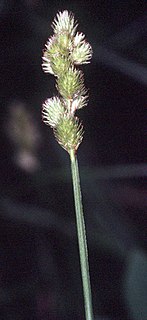
Carex is a vast genus of more than 2,000 species of grass-like plants in the family Cyperaceae, commonly known as sedges. Other members of the family Cyperaceae are also called sedges, however those of genus Carex may be called true sedges, and it is the most species-rich genus in the family. The study of Carex is known as caricology.

Carex nigra is a perennial species of plants in the family Cyperaceae native to wetlands of Europe, western Asia, northwestern Africa, and eastern North America. Common names include common sedge, black sedge or smooth black sedge. The eastern limit of its range reaches central Siberia, Turkey and probably the Caucasus.

Carex nebrascensis is a species of sedge known as Nebraska sedge.

Carex pensylvanica is a species of flowering plant in the sedge family commonly called Pennsylvania sedge. Other common names include early sedge, common oak sedge, and yellow sedge.

Carex panicea, commonly known as carnation sedge, is a plant species in the sedge family, Cyperaceae. It is known as grass-like sedge and can be found in Northern and Western Europe, and also in north-eastern North America. The plant produces fruits which are 3–4 millimetres (0.12–0.16 in) long, are egg shaped and spiked. Both male and female species leaves are pale blue on both sides.

Carex arctata, known as drooping woodland sedge, is a species of sedge native to eastern North America. It is sometimes called black sedge, compressed sedge, or drooping wood sedge. It occurs from Manitoba to the Maritimes in Canada, south to northwestern North Carolina, and west to Minnesota. Carex arctata grows in bogs, hardwood forests, and spruce forests.

Carex inversa, commonly known as knob sedge, is a species of sedge of the family Cyperaceae that is native to parts of Australia and New Zealand and has also been introduced into Great Britain.
Carex tereticaulis, also known as basket sedge, is a species of sedge of the family Cyperaceae that is native to southern parts of Western Australia, southern parts of South Australia, southern and eastern parts of New South Wales as well as north western and central Victoria and Tasmania. The Koori peoples know the plant as Poong'ort.

Carex davisii, known as Davis' sedge or awned graceful sedge, is a species of Carex native to North America. It is listed as an endangered, threatened, or species of concern across much of edge of its range. It was named in the 1820s by Lewis David de Schweinitz and John Torrey in honor of Emerson Davis (1798–1866), a Massachusetts educator and "enthusiastic student of the genus" Carex.

Carex amphibola, known as gray sedge, is a species of flowering plant in the family Cyperaceae. It was first formally named in 1855. Carex amphibola is native to the eastern United States and Canada.

Carex tribuloides, the blunt broom sedge, is a species of flowering plant in the genus Carex, native to the eastern United States, eastern Canada, and Veracruz in Mexico, and introduced in Sweden. It is an important food for soras during their spring migration.

Carex frankii, also known as Frank's sedge, is a widespread species of flowering plant in the family Cyperaceae, native to temperate eastern North America; Ontario, the central and eastern United States, and Coahuila, Mexico. Preferring to grow in wet, shady situations such as the edges of streams and ponds, and erosion resistant, it is recommended for rain gardens.

Carex flagellifera, the weeping brown sedge or Glen Murray tussock sedge, is a species of flowering plant in the family Cyperaceae. It is native to Tasmania, New Zealand, and the Chatham Islands, and it has been introduced to the Kermadec Islands and Great Britain. There are a number of cultivars, including 'Auburn Cascade', 'Coca-Cola', 'Frosted Curls', 'Kiwi', 'Rapunzel', and 'Toffee Twist'.
Carex houghtoniana, also known as Houghton's sedge, is a species of flowering plant in the sedge family, Cyperaceae. It is native to eastern Canada and the northeastern United States.

Carex alliiformis is a tussock-forming perennial sedge in the family Cyperaceae. It is native to eastern parts of Asia.

Carex breviscapa is a tussock-forming perennial in the family Cyperaceae. It is native to eastern parts of the south east Asia and north eastern Australia
Carex haematosaccus is a tussock-forming species of perennial sedge in the family Cyperaceae. It is native to central and eastern parts of Madagascar.
Carex lophocarpa is a tussock-forming species of perennial sedge in the family Cyperaceae. It is native to parts of eastern Australia.

Carex ferruginea, the rusty sedge or rust-coloured sedge, is a species of flowering plant in the family Cyperaceae. It is native to the Alps, the southern Carpathians, and the western Balkan Peninsula, and has been introduced to the US state of New Jersey. It is a glacial relict species.















